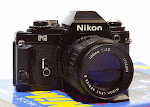A 50mm lens is not very wide nor is it really telescopic. For this reason it’s known as a normal lens. Why do we call it “normal”? It’s called a normal lens because it takes in an angle of view that is about the normal field of view we see the world around us.
A NORMAL LENS FOR 35mm FILM CAMERAS.

Lenses that cover wider fields of view are called wide-angle lenses while those that cover a narrower filed are called telephoto lenses.
50mm lenses are not normal lenses for all cameras. The larger the negative, the longer the focal length needed to create an image covering the normal field of view. This applies to digital cameras also. Some digital cameras will have a crop factor such as 1.5. Multiply the crop factor by your lens size to determine the proper focal length. Other digital cameras are full frame so the general film rule applies.
With a 35mm film camera a 50mm lens is considered normal.
Other normal lenses for different film sizes follow,
FILM CAMERAS
35mm = 50mm (normal)
21/4 x 21/4 = 75mm (normal)
4 x 5 = 150 (normal)
8 x 10 = 300mm (normal)
DIGITAL CROP FACTOR
1.5 crop = 35mm (normal) this equals 52.5mm equivalent to film.
1.4 crop = 35mm (normal) 49mm equivalent to film.
And so forth.
This is all approximation. Any lens between 40mm and 60mm could be considered a normal lens for a 35mm film camera. Same is said for the larger film sizes.
We can look at this from a different perspective. Lets try measuring the diagonal dimensions of a picture frame. The diagonal measurement of a 35mm frame is about 50mm long. There for the normal lens size for this film is about 50mm or there about. Same is to be said for other film sizes.
Remember that regardless of film size, the shorter the focal length, the wider it’s field of view. The longer the focal length the narrower it’s field of view.
TELEPHOTO
Previously I discussed the focal length as being the distance from the center of the lens to the film plane when focused at infinity. This would imply that the length of the lens barrel would have to be approximately the same length as the focal length. So, a 100mm lens would have to be 100mm long. But when measuring your lenses you will find that many are considerably shorter than their focal lengths.
Why? There are special lens elements that magnify the image. This enables a telephoto lens to be constructed in a shorter barrel, a lens that is as long as its focal length is generally called a long focus lens. Since most long lenses are of telephoto design, the term telephoto is applied (and sometimes misapplied).
A typical telephoto lens.

ANGLE OF COVERAGE
The angle of coverage depends on the lens focal length; the longer the lens focal length the narrower the angle of coverage.
Here are a few samples:
8mm = 180 degree angle of coverage.
28mm = 75 degree angle of coverage.
35mm = 63 degree angle of coverage.
50mm = 43 degree angle of coverage.
85mm = 29 degree angle of coverage.
135mm = 18 degree angle of coverage.
250mm = 10 degree angle of coverage.
350mm = 7 ½ degree angle of coverage.
500mm = 5 degree angle of coverage.

No comments:
Post a Comment